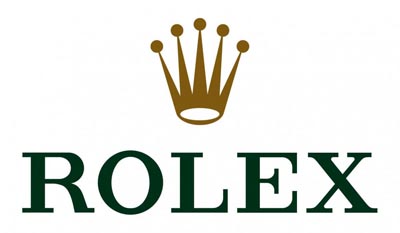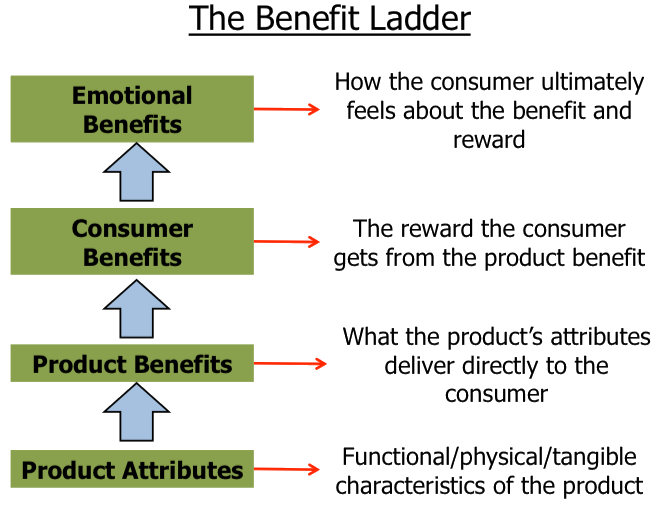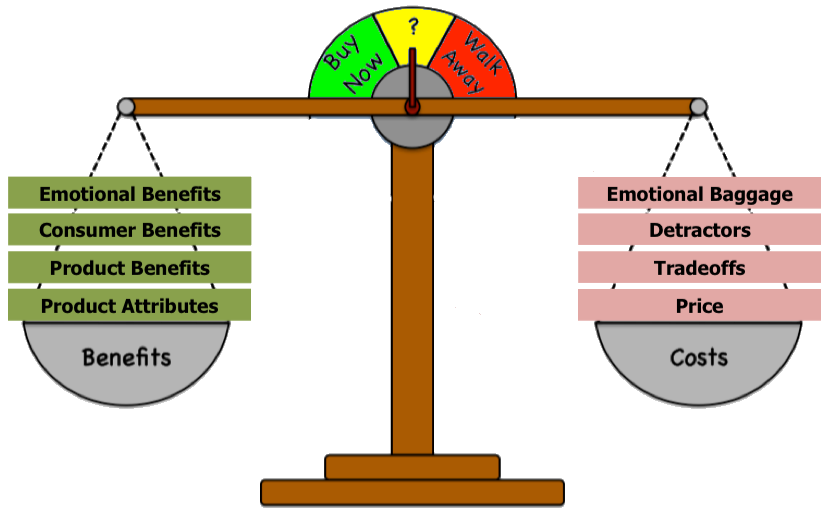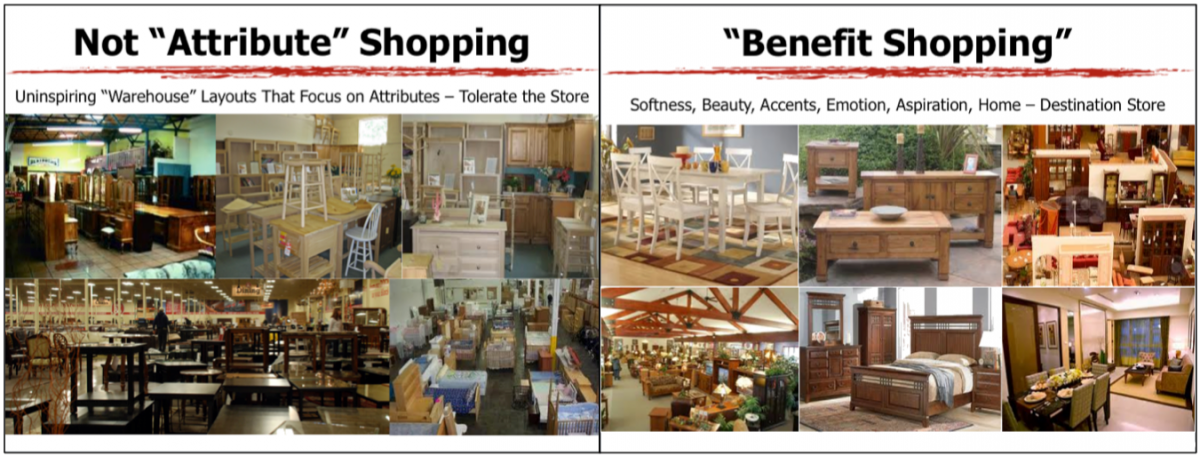Over the next few weeks in a three part series, I’ll give you a summary of what was presented at the Authentic Home Furnishing Association’s annual trade show (minus the consultant jokes which were pretty good). If you need more, you’ll have to give me a call. I can’t share confidential information or more than what was shared in the presentation but I can provide clarity where needed.
The presentation was built around three “steps” on a path to growth (granted, Bob Wiley would call them baby steps).
Part 2 – Successful Businesses Know Their Consumer
 All consumers buy benefits. There’s a hierarchy to the benefits as seen in the benefit ladder. If I buy a Rolex watch, I’m not just buying the functional, physical product attributes (e.g., watch face with numbers and hands, glass protective cover, silver and gold band, self-winding, date function, brand logo, etc.). I’m buying the benefits those attributes deliver to me as well – correct time, date at a glance, the look and feel of the watch, beauty, brand recognition. And those product benefits give me rewards like being on time, quick access to the date when I write a check, something to wear that looks nice when I dress up, and favorable impressions from those I’m with. And finally, that Rolex watch I’m buying isn’t just about the attributes, product benefits and the rewards it provides. Ultimately, it makes me feel a certain way – important, somebody, “I’ve arrived”. In other words, it also provides emotional benefits.
All consumers buy benefits. There’s a hierarchy to the benefits as seen in the benefit ladder. If I buy a Rolex watch, I’m not just buying the functional, physical product attributes (e.g., watch face with numbers and hands, glass protective cover, silver and gold band, self-winding, date function, brand logo, etc.). I’m buying the benefits those attributes deliver to me as well – correct time, date at a glance, the look and feel of the watch, beauty, brand recognition. And those product benefits give me rewards like being on time, quick access to the date when I write a check, something to wear that looks nice when I dress up, and favorable impressions from those I’m with. And finally, that Rolex watch I’m buying isn’t just about the attributes, product benefits and the rewards it provides. Ultimately, it makes me feel a certain way – important, somebody, “I’ve arrived”. In other words, it also provides emotional benefits.

And benefits are used to determine value. Consumers consciously or unconsciously weigh all the benefits in the benefits ladder against all the costs. Costs aren’t limited to just the price. Costs include tradeoffs the consumer has to make (like how far I have to travel to find the Rolex watch or what I won’t be able to buy instead). It also includes detractors. For example, I may be willing to pay the price of the Rolex and I may even be willing to make tradeoffs to get it. But if the store is a dump and the sales person is offensive, I’ll probably walk out and not make the purchase. And finally, there’s the emotional baggage I have to weigh to determine value. What if my friends think I’m uppity or arrogant or wasteful for buying a Rolex? Do I really want to face into those emotional issues every time I put my watch on?
not make the purchase. And finally, there’s the emotional baggage I have to weigh to determine value. What if my friends think I’m uppity or arrogant or wasteful for buying a Rolex? Do I really want to face into those emotional issues every time I put my watch on?
So, that’s how value decisions are made: weighing the benefits versus the costs. But who’s making those value judgments? Successful businesses know the consumer, who they are demographically and psychographically, what they’re thinking on every rung of the benefit ladder, and how value judgments are being made. In the home furnishings industry, the primary consumer is a woman. Women drive more than 90% of all  purchases in your industry segment. And believe me, men and women shop differently. I’m speaking in generalities but a man shops for attributes first that affirm their emotions (“This table is solid wood with a durable finish… Our family will love this table!”). But in general, women shop relationally and emotionally first and confirm their emotions with product attributes (“I love this table and can see our family around it… and it’s solid wood too!”).
purchases in your industry segment. And believe me, men and women shop differently. I’m speaking in generalities but a man shops for attributes first that affirm their emotions (“This table is solid wood with a durable finish… Our family will love this table!”). But in general, women shop relationally and emotionally first and confirm their emotions with product attributes (“I love this table and can see our family around it… and it’s solid wood too!”).
The current disconnect in this industry segment is that most retailers are selling well-differentiated product attributes (solid wood, custom finish, etc.) but the primary consumers are looking for and buying benefits. Women may be of all different types of demographics – young professionals, career woman, supermom, burgeoning empty nester – but they have very similar shopping expectations. They want a shopping experience that’s aspirational, gives a feeling of home, and provides furnishings that have authenticity. And none of them really want to settle if they don’t have to.
They’re not attribute shopping. So if your store has an uninspiring “warehouse” layout that focuses on attributes, at best your consumers will tolerate the store.

Instead, women are benefit shopping. They’re looking for a store they want to spend time in where they can imagine and dream. One that feels (and smells) like the home they aspire to. Successful businesses know their consumers very well and configure their business model and store sets to properly appeal to them.